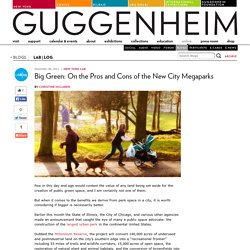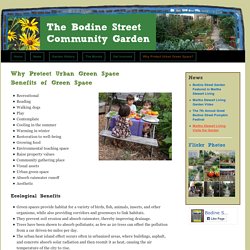

Green Spaces
202020 Vision. Australia's biggest collection of green space information.

Got one to add? Contact us 202020 Vision Plan The green space projects you told us need to happen to create 20% more green space in our urban areas by 2020. Download 202020 Vision Instant Plant Plan. What is green space? What is green space worth? Recent patterns of residential development in Australian cities are threatening to overwhelm green space in our urban cores.

Policies of urban consolidation have concentrated medium to high density residential development in inner ring suburbs where green space is comparatively scarce. And the zoning and development regulations of many local authorities actually allow a reduction of green space for higher density development – usually without any justification. Industrial Revolution. The textile industry, in particular, was transformed by industrialization.

Before mechanization and factories, textiles were made mainly in people’s homes (giving rise to the term cottage industry), with merchants often providing the raw materials and basic equipment, and then picking up the finished product. History of Melbourne. Above and the 2 below, a couple of oldies.

Above, Melbourne ~ 1980. Melbourne Airport ~ 1970s. Above, the MCG Photoshoped to look ready for the Commonwealth Games. Melbourne's mega-city needs new boundary, plan says. Source: Department of Transport, Planning and Local Infrastructure A permanent urban boundary to contain Melbourne's sprawl is part of the new blueprint to deal with the city's booming population, now forecast to hit almost eight million by 2051.

The government's new Plan Melbourne declares the need for a ''clear statement'' on the boundary. But the final line could be different to the existing limits, with the plan setting up a mechanism to determine it. The views of councils, the city's physical features and boundaries formed by major infrastructure are among the factors that will be considered by the new Metropolitan Planning Authority, which will implement the new strategy.
The plan includes sweeping revisions to Melbourne's population, now at 4.3 million, with the city expected to hit 7.7 million people by 2051, up from 6.5 million forecast in the draft of the plan only seven months ago. Warrigal Road-Looking South, 1936. H0940-1436319575-4823-004_Open2view_ID362039-1146_Glen_Huntly_Rd__Glen_Huntly_-_RWOC.jpg.ashx (JPEG Image, 720 × 540 pixels)
The Right Environmentality. Biophilia hypothesis. Bridge Road, Melbourne. 3026306-poster-p-1-how-los-angeles-is-kind-of-almost-a-startup-town.jpg (JPEG Image, 1280 × 720 pixels) - Scaled (80%) Big Green: On the Pros and Cons of the New City Megaparks. Few in this day and age would contest the value of any land being set aside for the creation of public green space, and I am certainly not one of them.

But when it comes to the benefits we derive from park space in a city, it is worth considering if bigger is necessarily better. The Bodine Street Community Garden. RecreationalReadingWalking dogsPlayContemplateCooling in the summerWarming in winterRestoration to well-beingGrowing foodEnvironmental teaching spaceRaise property valuesCommunity gathering placeVisual assetsUrban green spaceAbsorb rainwater runoffAesthetic Reduces liquid waste and water consumption (low-flow plumbing, rainwater collection, drought-resistant landscaping etc.)Reduces solid waste (household garbage limits etc.)Provides local recycling and composting centers.Is a community facilities constructed in environmentally sound ways.Community gardens provide chemical-free food production and gardening.

Displays public art.Offers green spaces for birds, animals, and plants, understanding that green spaces are important not just for human recreation/use. Biophilia hypothesis. 246 × 316 - wilderdom.com 470 × 314 - mouthfulofrubies.wordpress.com.

Biodiversity.pdf. The Center for Health and the Global Environment. The eminent Harvard biology professor Edward O.

Wilson once said about ants, “We need them to survive, but they don’t need us at all.” The same, in fact, could be said about countless other insects, bacteria, fungi, plankton, plants and other organisms. Yet, we humans often act as if we are totally independent of our environment, as if our driving thousands of other species to extinction, and disrupting the life-giving services they provide, will have no effect on us whatsoever.
The fundamental truth is that biodiversity matters profoundly to human health in almost every conceivable way. The health benefits of urban green spaces: a review of the evidence. Green space, urbanity, and health: how strong is the relation? Energy and Climate in the Urban Built Environment - Matheos Santamouris, Demosthenes N. Asimakopoulos. Tony Abbott is ignoring problems of cities: traffic, urban sprawl. It’s not getting any easier living in our major cities.

Picture: Craig Wilson Source: News Corp Australia THE 15 million Australians living in our mainland capital cities have been left out of federal government policy at a time of massive shifts in population and employment. This is the year in which the Coalition had promised a national livability index to rate major cities on such matters as traffic congestion and neighbourhood safety. But there is no index, and specific policies for cities have vanished from the Coalition’s priorities. This is despite big demographic and economic shifts which will see Sydney’s population soon reach five million and Melbourne become Australia’s largest city by 2051. And that could mean it will get harder to live in your favourite city — with traffic jams and long hikes to school and work getting worse. Melbourne is set to grow larger than Sydney in coming decades. 0c9605316fc2a0330f000000.pdf. Nature, race, and parks: past research and future directions for geographic research.